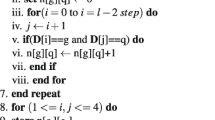Abstract
A new method for reconstructing evolutionary relationship among bacteria by use of rRNA sequence data is proposed. The method is based on the concept of fuzzy classification of probabilitiesp(i), p(i/j) andp(i/j*) (i=A,G,C,U) of each sequence. The resulting partition tree shares common features of previous works but has some new peculiarities.
Similar content being viewed by others
References
Bernardi, G. and G. Bernardi. 1986. Compositional constraints and genome evolution.J. Mol. Evol. 24, 1–11.
Blaisdell, B. E. 1986. A measure of the similarity of sets of sequences not requiring sequence alignment.Proc. Nat. Acad. Sci. 83, 5155–5159.
Fitch, W. M. 1986. Unsolved problems in DNA sequence analysis.Lect. Math. Life Sci. 17, 1–18.
Gatlin, L. 1972.Information Theory and the Living System. Columbia University Press.
Kulback, S. 1951.Information Theory and Statistics. New York: Wiley.
Lake, J. A.,1987. Prokaryotes and archaebacteria are not monophyletic.Cold Spring Harbor Symposia on Quantitative Biology 52, 839–846.
Lake, J. A., E. Henderson, M. Oakes, M. W. Clark. 1984. Eocytes: a new ribosome structure indicates a kingdom with a close relationship to eukaryotes.Proc. Natl. Acad. Sci. 81, 3786.
Luo, L. F., H. Li. 1991. The statistical correlation of nucleotides in protein-coding DNA sequences.Bull. math. Biol. 53, 345–353.
Luo, L. F., L. Tsai and Y. M. Zhou. 1988. Informational parameters of nucleic acid and molecular evolution.J. Theor. Biol. 130, 351–361.
Luo, L. F. and L. E. H. Trainor. 1992. A stochastic evolutionary model of molecular sequences.J. Theor. Biol. 157, 83–94.
Olson, G. J. 1987. Earliest phylogenetic branchings: comparing rRNA-based evolutionary trees inferred with various techniques.Cold Spring Harbor Symposia on Quantitative Biology 52, 825–837.
Woese, C. R. 1987. Bacterial evolution.Microbiol. Rev. 51, 221–271.
Woese, C. R. 1991. The use of rRNA in reconstructing evolutionary relationships among bacteria. InEvolution at the Molecular Level, R. K. Selander (Ed.), p. 1. Sinauer Associates Inc.
Woese, C. R. and G. E. Fox. 1977. The concept of cellular evolution.J. Mol. Evol. 10, 1–6.
Zadeh, L. A. 1971. Similarity relation and fuzzy orderings.Inf. Sci. 3, 177–206.
Author information
Authors and Affiliations
Rights and permissions
About this article
Cite this article
Luo, L., Ji, F. & Li, H. Fuzzy classification of nucleotide sequences and bacterial evolution. Bltn Mathcal Biology 57, 527–537 (1995). https://doi.org/10.1007/BF02460781
Received:
Accepted:
Issue Date:
DOI: https://doi.org/10.1007/BF02460781




